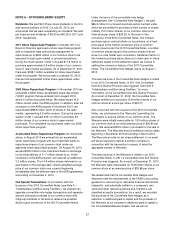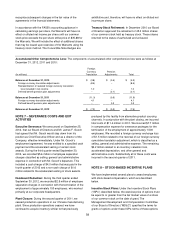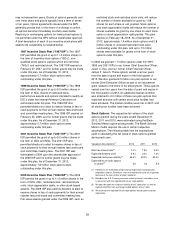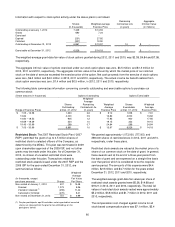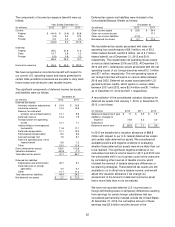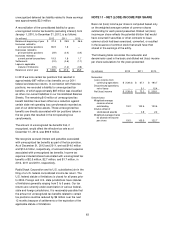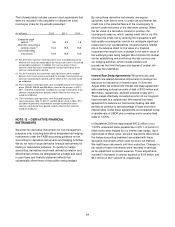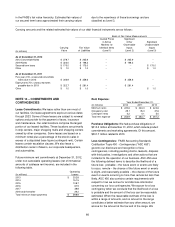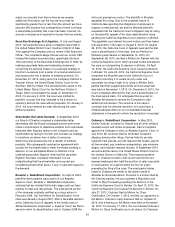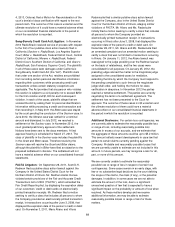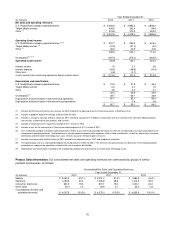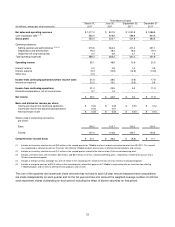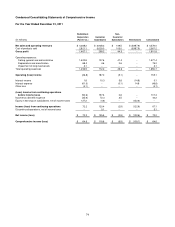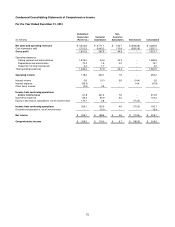Radio Shack 2012 Annual Report Download - page 68
Download and view the complete annual report
Please find page 68 of the 2012 Radio Shack annual report below. You can navigate through the pages in the report by either clicking on the pages listed below, or by using the keyword search tool below to find specific information within the annual report.
66
in the FASB’s fair value hierarchy. Estimated fair values of
our secured term loans approximated their carrying values
due to the recentness of these borrowings and are
classified as Level 3.
Carrying amounts and the related estimated fair values of our debt financial instruments are as follows:
Basis of Fair Value Measurements
Carrying
Value
Fair Value
of Liabilities
Quoted Prices
in Active
Markets for
Identical Items
(Level 1)
Significant
Other
Observable
Inputs
(Level 2)
Significant
Unobservable
Inputs
(Level 3)
(In millions)
As of December 31, 2012
2013 Convertible Notes $ 278.7 $ 265.9 -- $ 265.9 --
2019 Notes $ 323.0 $ 198.3 -- $ 198.3 --
Secured term loans $ 175.0 $ 175.0 -- -- $ 175.0
Other $ 1.0 $ 1.0 -- -- $ 1.0
As of December 31, 2011
Five year 2.5% unsecured convertible
notes due in 2013
$ 346.9
$ 358.6
--
$ 358.6
--
Eight year 6.75% unsecured notes
payable due in 2019
$ 322.7
$ 281.4
--
$ 281.4
--
Other $ 1.0 $ 1.0 -- -- $ 1.0
NOTE 14 – COMMITMENTS AND
CONTINGENCIES
Lease Commitments: We lease rather than own most of
our facilities. Our lease agreements expire at various dates
through 2023. Some of these leases are subject to renewal
options and provide for the payment of taxes, insurance
and maintenance. Our retail locations comprise the largest
portion of our leased facilities. These locations are primarily
in strip centers, major shopping malls and shopping centers
owned by other companies. Some leases are based on a
minimum rental plus a percentage of the store's sales in
excess of a stipulated base figure (contingent rent). Certain
leases contain escalation clauses. We also lease a
distribution center in Mexico, our corporate headquarters,
and automobiles.
Future minimum rent commitments at December 31, 2012,
under non-cancelable operating leases (net of immaterial
amounts of sublease rent income), are included in the
following table.
(In millions)
Operating
Leases
2013 $ 202.8
2014 151.5
2015 108.7
2016 67.9
2017 38.8
2018 and thereafter 29.2
Total minimum lease payments $ 598.9
Rent Expense:
Year Ended December 31,
(In millions) 2012 2011 2010
Minimum rents $ 220.6
$ 224.3
$ 224.6
Occupancy cost 29.1
35.3
37.6
Contingent rents 4.2
4.1
5.0
Total rent expense $ 253.9
$ 263.7
$ 267.2
Purchase Obligations: We had purchase obligations of
$313.0 million at December 31, 2012, which include product
commitments and marketing agreements. Of this amount,
$301.7 million related to 2013.
Loss Contingencies: FASB Accounting Standards
Codification Topic 450 - Contingencies (“ASC 450”)
governs our disclosure and recognition of loss
contingencies, including pending claims, lawsuits, disputes
with third parties, investigations and other actions that are
incidental to the operation of our business. ASC 450 uses
the following defined terms to describe the likelihood of a
future loss: probable – the future event or events are likely
to occur, remote – the chance of the future event or events
is slight, and reasonably possible – the chance of the future
event or events occurring is more than remote but less than
likely. ASC 450 also contains certain requirements with
respect to how we accrue for and disclose information
concerning our loss contingencies. We accrue for a loss
contingency when we conclude that the likelihood of a loss
is probable and the amount of the loss can be reasonably
estimated. When the reasonable estimate of the loss is
within a range of amounts, and no amount in the range
constitutes a better estimate than any other amount, we
accrue for the amount at the low end of the range. We



